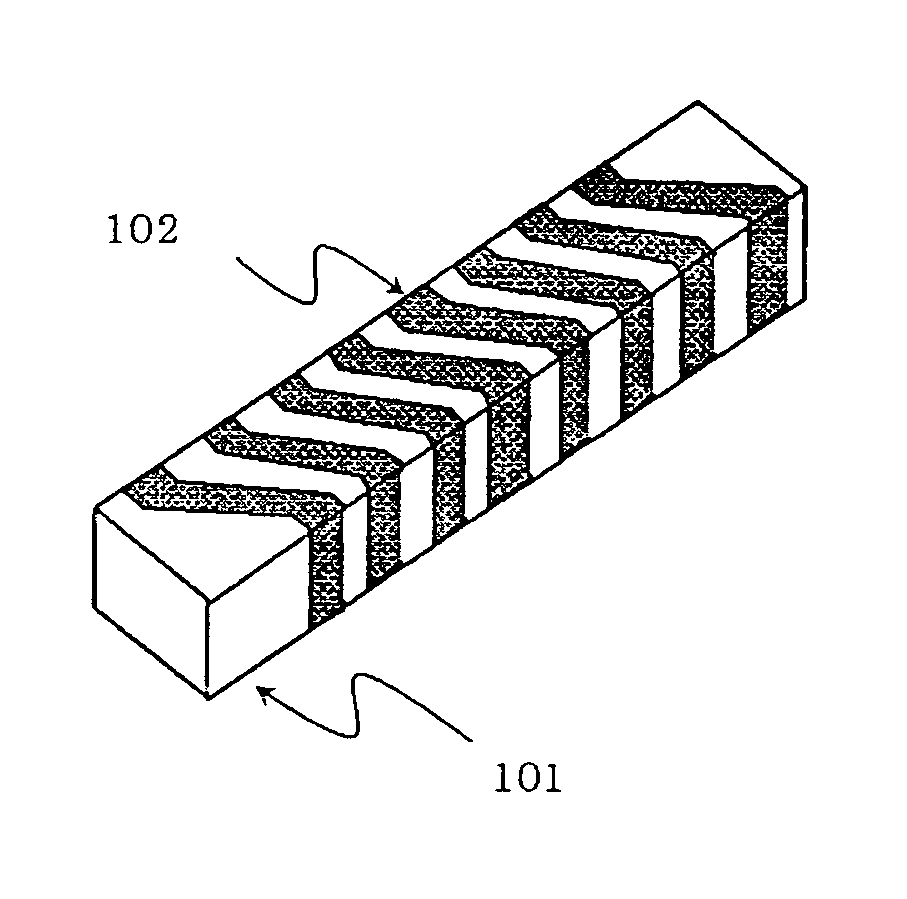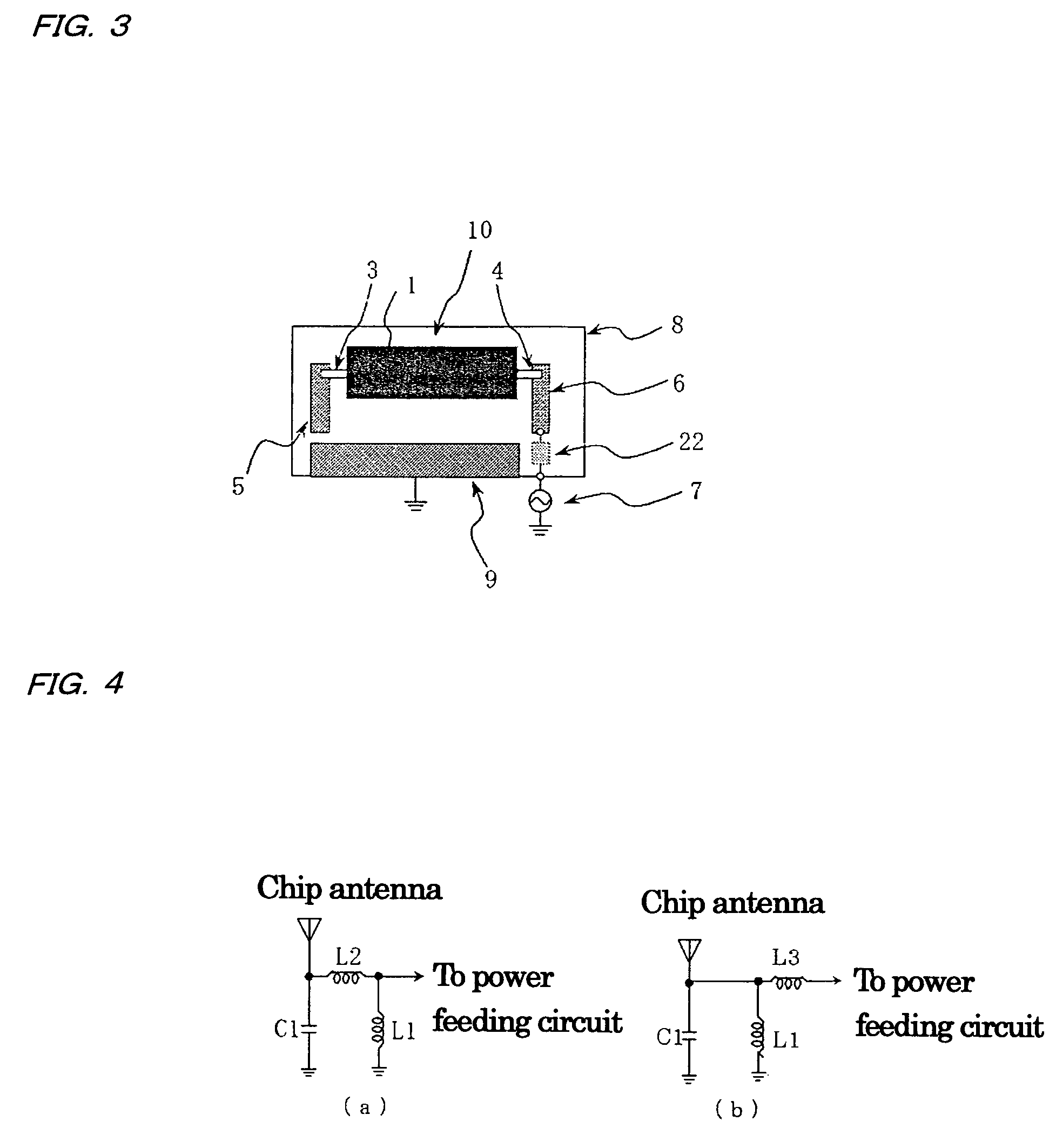Magnetic material antenna and ferrite sintered body
a technology of ferrite and sintered body, which is applied in the direction of ferromagnetic core loop antennas, magnetic bodies, protective material radiating elements, etc., can solve the problem of limit to high frequency regions, and achieve the effect of high sintered body strength, low volume resistivity, and loss factor
- Summary
- Abstract
- Description
- Claims
- Application Information
AI Technical Summary
Benefits of technology
Problems solved by technology
Method used
Image
Examples
embodiments
Embodiment 1
[0037]A material obtained by adding 0.6 weight parts of CuO with respect to 100 weight part of main components including Fe2O3, BaO (BaCO3 was used), and CoO (Co3O4 was used) as main components and containing 60 mol %, 20 mol %, and 20 mol %, respectively was mixed by a wet ball mill using water as a medium for 16 hours.
[0038]Next, the mixed powder, after being dried, was calcined at 900 to 1200° C. in an air atmosphere for two hours and for the comparative example at 1100° C. also in an air atmosphere for two hours. The calcined powder was milled by the wet ball mill for 18 hours using water as a medium. To the milled powder obtained thus was added the 1% polyvinyl alcohol (PVA) binder and then granulated. After the granulation, the granulated substance was compression molded into a ring-shaped and cuboid-shaped substance and then sintered at 1160 to 1200° C. in an air atmosphere or in an oxygen atmosphere at 1180 to 1240° C. in the air atmosphere for three hours to obt...
embodiment 2
[0040]Next, a material obtained by adding weight parts of CuO shown in Table (No. 1 to 5) with respect to 100 weight parts of main components including Fe2O3, BaO (BaCO3 was used), and CoO (CO3O4 was used) as main components and containing 60 mol %, 20 mol %, and 20 mol %, respectively, were mixed by a wet ball mill using water as a medium for 16 hours. Moreover, another material mixture serving as a comparative example of the Z-type ferrite including Fe2O3, BaO (BaCO3 was used), and CoO (Co3O4 was used) as main components and containing 70.6 mol %, 17.6 mol %, and 11.8 mol %, respectively, were mixed by a wet ball mill using water as a medium for 16 hours.
[0041]Then, the mixed powder, after being dried, was calcined in an air atmosphere at 1000° C. for two hours and the comparative material was calcined in an air atmosphere at 1100° C. for two hours. The powder obtained by calcination was milled by a wet ball mill by using water as a medium for 18 hours. To the milled powder was ad...
embodiment 3
[0044]The materials including Fe2O3, BaCO3, and Co3O4 obtained by weighing so as to have compositions (No. 7 to 13) represented by Ba2Co2-xCuxFe12O22 (x=0.08, 0.12, 0.15, 0.20, 0.50, 0.75, 1.00) was mixed by a wet ball mill using water as a medium for 16 hours. Next, the mixture, after being dried, was calcined in an air atmosphere at 1000° C. for two hours. The calcined powder was milled by a wet ball mill using water as a medium for 18 hours. To the milled powder obtained thus was added a 1% PVA binder to be granulated. After the granulation, the granulated substance was compression molded into a ring-shaped and cuboid-shaped substance and then sintered at 1200° C. in an oxygen atmosphere for three hours. The vacancy rate, initial permeability μi, loss factor tan δ, volume resistivity, area rate of Co-rich phase, average grain diameter of the Co-rich phase of the obtained sintered body were evaluated by the same way as in Embodiments 1 and 2. The result from the evaluation are sho...
PUM
| Property | Measurement | Unit |
|---|---|---|
| volume resistivity | aaaaa | aaaaa |
| loss factor tan δ | aaaaa | aaaaa |
| frequency | aaaaa | aaaaa |
Abstract
Description
Claims
Application Information
 Login to View More
Login to View More - R&D
- Intellectual Property
- Life Sciences
- Materials
- Tech Scout
- Unparalleled Data Quality
- Higher Quality Content
- 60% Fewer Hallucinations
Browse by: Latest US Patents, China's latest patents, Technical Efficacy Thesaurus, Application Domain, Technology Topic, Popular Technical Reports.
© 2025 PatSnap. All rights reserved.Legal|Privacy policy|Modern Slavery Act Transparency Statement|Sitemap|About US| Contact US: help@patsnap.com



